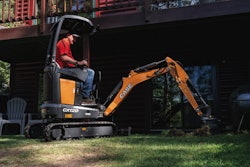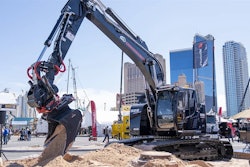Motor graders are one of those machines that can run for a decade without incurring a lot of increasing costs as they age. So your costs per hour and cost per year should remain fairly steady on similar applications. But as with any machine, being able to accurately calculate your exact cost per hour, both fixed and variable costs, enables you to know what you have to charge for that machine’s services in order to make a profit.
The most common size of motor grader sold to private (non-governmental) contractors is in the 30,000- to 35,000-pound range, says Gary Atkinson, regional product manager, road products, for Volvo Construction Equipment. These typically have 150-to-200-horsepower engines and 12-to-14-foot blade lengths. The Volvo motor grader that fits these parameters is the Volvo 930 G.
The numbers we cite in this article are general in nature and given only as a reference and for discussion purposes. When figuring your own owning and operating costs for a motor grader you’ll need to do considerably more detailed calculations. Volvo has a spreadsheet type calculator on its website that can help you work up these numbers. You can find it at www.volvo.com/constructionequipment and click on the machine you’re interested in and then the “Cost of ownership” tab.
The lifecycle for this size of motor grader is not easy to pin down. Some contractors keep them five years and trade. Others may keep them a decade or more, Atkinson says. Government agencies and departments of transportations also tend to keep their motor graders longer than contractors do in the private sector. Typical usage on the private side would be about 1,500 hours per year; the public sector less than half that.
Since motor graders don’t have expensive high-wear components like crawler undercarriages or engines that undergo heavy-duty cycles, there are no high-ticket rebuild items to consider when costing out a motor grader. “At five years a motor grader has plenty of life left in it without having to get into any overhauls,” Atkinson says.
Rewarding top operators
A lot of what drives turnover is employee retention, Atkinson says. “The motor grader operator is almost always the best and most experienced equipment operator on a site. He’s usually the most senior individual and the most valuable. Putting him into a brand new motor grader every now and then is part of taking care of him, keeping him motivated.”
Tire choice and longevity
As with many types of equipment, tires play a big role in the long term operating costs of a motor grader. The Volvo 930G takes a set of six 17.5-25 size tires. These generally cost a little more than $1,000 each, so we figured $7,500 for a set for bias-ply tires in this exercise. But many contractors today are opting for radials. These can cost considerably more, but they improve traction and thus increase productivity. And they can last two to three times longer. And since motor graders are mostly working on debris-free surfaces there’s little chance of ruining one on a piece of rock, root or rebar. So amortized over the life of the machine, the cost of a set of radials won’t make a big difference in the hourly rate, but they will enable the machine to do more work and thus make you more money in a given time frame.
Ground engaging tools
A conventional 12- or 14-foot bolt-on cutting edge on a motor grader can last a contractor 30 days or one afternoon, Atkinson says. It depends on the material and how it’s being handled. There are also specialty cutting edges, such as those with carbide inserts, designed to handle extremely abrasive materials. Let experience be your guide here. If you encounter high wear on your cutting edges or require specialty edges, factor this into your costs.
Fuel costs
You can’t do much about the price you pay for diesel fuel, but the skill and diligence of your operator can help conserve this expensive consumable on the operating side of the equation. “I’ve seen numbers as low as 2.1 gallons per hour and as high as 5 gallons per hours,” Atkinson says. “The average we’re looking at is 3.1 to 3.5 gallons per hour in a typical contractor application, but it varies widely depending on operator techniques.”
The best way to improve fuel economy is to run the machine within its peak torque speed, Atkinson says. “Most diesel engines are going to be most efficient when they’re operating within a couple hundred rpm of their peak torque. But we occasionally see operators who insist on running wide open all the time.
Your operator should choose a comfortable ground speed, fast enough to do the work efficiently but not so fast as to cause the machine to bounce. Auto shift transmissions and close gear ratios can also help keep rpms down and save on fuel.
Maintenance and repairs
The cost of doing preventive or regularly scheduled maintenance on a motor grader is largely a matter of your labor expense. In this model we’re estimating that to be $65 an hour. Engine oil changes come at 250-hour intervals on the Volvo 930G. Some contractors may want to extend oil drains to 500 hours. When doing so, however, it’s recommended that you perform oil sampling on the machine, and you may need to use a higher quality oil, possibly synthetic, and/or a more expensive filter. So when figuring your costs make sure to pencil in these figures as well.
Hydraulic cylinder technology as well as that of many other components has gotten so good in the last few years that these rarely need replacement or rebuilding in a motor grader’s first lifecycle, Atkinson says. The area you do want to pay attention to is the circle. The components that hold the moldboard and circle in position don’t wear out, but they do loosen up over time. Keeping them tight improves your grader’s accuracy and ultimately its performance.
OWNING AND OPERATING COST BREAKDOWNS*
MOTOR GRADERS
Depreciation time 5 years/1,500 hours per year
OWNING COSTS
Depreciation time: 5 years/1,500 hours per year
Purchase price: $263,053
Purchase price excluding tires: $255,553**
Residual/resale value(@ $29,271 depreciation per year): $109,200
Interest cost (@ 6 percent interest, $11,168 per year): $55,840
Insurance (@ $5,261 per year): $26,305
*Note: Because state laws on taxes vary from state to state we’ve omitted taxes from this equation. Be sure to build these back into any calculations you do on motor graders or any other capital purchase.
**Tires, because they are a wear item and replaced before the end of a machine’s first lifecycle, are treated as an operating expense, rather than a fixed cost.
CUTTING EDGE
5 years Per hour
$4,875 $0.65
OPERATOR WAGES/BENEFITS
Assumes $35 per hour wage plus 35 percent for benefits. 5 years: $324,000; Per hour: $43.20
PREVENTIVE MAINTENANCE
@ $65 per hour labor cost. 5 years: $28,875; Per hour: $3.85
REPAIR COSTS
@ $85 per hour labor cost. 5 years: $18,375; Per hour: $2.45
Fuel
@ 3.2 gallons per hour x $2.80 per gallon. 5 years: $67,200; Per hour: $8.96
Tires
5 years: $17,625; Per hour: $2.35
COST SUMMARY
SUBTOTAL OWNING COSTS
5 years: $228,498; Per hour: $30.47
SUBTOTAL OPERATING COST
5 years: $460,950; Per hour: $61.46
TOTAL O&O COSTS
5 years: $689,475; Per hour: $91.93
Note: The dollar amounts and other numbers given here are theoretical and for discussion purposes only. For a more accurate O&O cost calculation consult with your local dealer.








